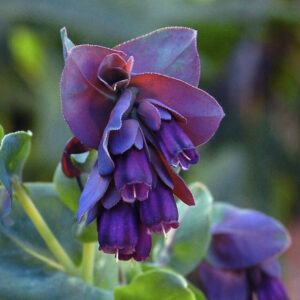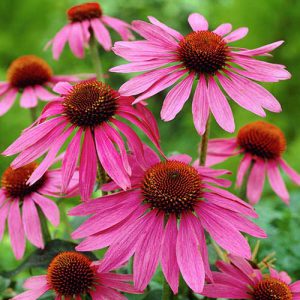- 1-9 pkts $4.50
- 10 pkts FREE
- Express post $12
Moluccella laevis
BELLS OF IRELAND
BULK FLOWER FARMERS PACK
Moluccella laevis BELLS OF IRELAND is a classic commercial cut flower and a much loved, heritage plant for cottage gardens.
Spires of bright emerald green bells
There is no other flower anything like Bells of Ireland.
It bears tall, strong stems, densely packed from tip to knee with fresh emerald-green, large bells.
These big, green bells are actually calyx, cupped around the true flowers, which are tiny white blossoms with a sweet scent.
Sweet & delicate citrus scent
The tiny white true flowers are insignificant – you grow Bells of Ireland for the spectacular green bells – but the flowers emit a sweet, light, citrus-like scent.
The perfume also persists when the stems are cut and displayed in a vase.
Superb floristry flowers
Blooming stems can be cut and used either fresh or dried in spectacular flower arrangements.
With their showy, emerald-green they make a very striking statement, and of course combine with flowers of any other colour.
The tall stems are stout and strong.
Long vase life
Fresh cut flower stems have a long vase life of up to 2 weeks.
While dried stems act like everlastings and have a very long life indeed in arrangements.
Just hang them upside down in a dry place out of strong light, to best preserve their colour and scent.
Spectacular in the garden or harvest
Harvest stems for floristry as soon as the green bells are open and brilliant green, as older stems produce little thorns that are not so pleasant for the flower arranger, and the colour is not so intense.
In the garden they can just be left to get on with a stunning display, especially when used at the back of a flower bed.
The good luck of the Irish
Bells of Ireland are a symbol of good luck and prosperity in the old language of flowers, and have been a popular floristry flower since 1570.
So by sending a bouquet of them you are sending lucky wishes.
But Bells of Ireland actually have nothing to do with Ireland (other than being very green).
In fact they are native to Turkiye, Syria and Iraq.
Make a big show in a pot
Bells of Ireland look stunning mixed into a pot or small garden, with other flowers of any colour.
They are suitable for growing on a balcony in a container or restricted garden space.
Because they give height and spectacle without taking up too much room.
Quick from seed to flower display
The time from sowing the seed to flower display and harvesting is usually about 13-14 weeks.
Plant in full sun to partial shade
Plant Moluccella laevis in full sun or partially shaded positions.
They do not require rich soil, and will happily grow in a wide range of soils, as long as well drained.
They are easy, fast and unfussy to grow, and though they require regular water to give their best, they are not big water-users.
But add some lime if your area has acid pH soil.
Grow in the winter if you garden in the tropics & subtropics
Bells of Ireland are grown as a winter bloomer in tropical and sub-tropical areas.
Or in spring & autumn in temperate areas
While in temperate and cool climates they are grown to flower through the spring and early summer, and the autumn and early winter.
Best to avoid the heat and humidity of high summer in all areas.
Low maintenance & easy care
Moluccella laevis is rarely if ever troubled by pests or diseases.
Though cutting the leading spire when the plant is still young, and regular harvesting is good, as this encourages lots more side spires.
Rabbits & deer rarely trouble Bells of Ireland
The munching pests do not seem to like the flavour.
Self-sowing, old fashioned annual
Bells of Ireland will happily do it themselves, and seed themselves into the garden for next year – if you leave a few stems to dry on the bush and drop their seed.
80-90cm. tall, slender spires of large green bells x 30cm. wide clump of foliage.
SEED SOWING ADVICE:
Seeds of Moluccella laevis are often direct sown into the garden or commercial flower field.
In tropical & sub-tropical areas: Sow the seed in autumn for a winter display.
In temperate & cool areas: Sow the seed in late winter-early spring and / or again in autumn-early winter. This gives you 2 crops per year.
The plants flower best when the weather is not too hot and humid – so sowing should be timed to avoid mid-summer blooming.
OR
Sow at any time indoors in punnets, whenever suitable temperatures can be provided (15-18°C).
Sow indoors for early plants: First soak the seeds in warm (not boiling) water that has previously been boiled in the kettle. (Also do this if you are sowing directly into the garden).
This will help to soften the hard seed coating and allow germination.
Now sow the seeds in a punnet on the surface of good quality seed raising mix.
And pat gently to ensure good contact with the mix.
But do not cover because these seeds need light to germinate.
Now thoroughly moisten the punnet by standing it in a shallow water bath.
And allowing the moisture to percolate up to the surface of the mix from below.
Then drain and wrap the sown, moist punnet in cling-wrap and place in the fridge (not freezer) for 2 weeks. This will also help to much improve the germination rate.
After 2 weeks of chilling, remove form fridge, moisten in the water-bath again.
Then place the punnet in a warm, well-lit position (with good light but no direct sunlight).
Keep the seeds warm & moist
Temperatures of 15-18°C approx. are ideal for rapid and optimum germination.
You can use a heat mat to maintain suitable warmth.
Continue to keep the punnet moist by misting the punnet from a spray water bottle regularly.
Covering the punnet with a clear plastic cover will also help to maintain necessary consistent moisture.
Remove the clear covering once germination has commenced.
Seeds germinate in approx. 14-28 days.
But do not discard the punnet too quickly, as it is natural for these seeds to stagger their germination.
Once the seedlings have developed their first true leaves, prick out of the seedlings into small pots or plant out into the garden.
The seedlings quickly develop a tap root – so prick them out into deeper little pots or garden as soon as possible.
Seed Count: 150 seeds per pack approx.
(We always aim to exceed the stated seed count, and give a generous serve).
Click here for Nursery Open Days & Open Gardens Information
https://www.gardivalia.com.au/open-gardens
Click here to go back to Seeds Shop
https://www.seedscape.net.au/shop/
Related products
-
Add to WishlistAlready In WishlistAdd to Wishlist
-
Add to WishlistAlready In WishlistAdd to Wishlist
-
Add to WishlistAlready In WishlistAdd to Wishlist
-
Add to WishlistAlready In WishlistAdd to Wishlist





